C. Litka's Blog, page 50
August 16, 2020
Origin Stories -- Beneath the Lanterns Part One

First, a bit of background. I spent over two year writing The Lost Star’s Sea,and it got to be somewhat of a grind finishing it. I vowed never again to write something that long. And I vowed never again to write a sequel to a book that sold less then several tens of thousands of copies. (I have since broken that vow, but it was a case of “any port in a storm,” I needed to write something...) Sequels appeal only to readers of the previous volumes, and not all of them, while with a new, standalone book, you start fresh, so anything can happen, including lightning striking.
So after The Lost Star’s Sea, I wanted to do something new, to appeal to a different, and wider readership. I felt that a fantasy that might attract new readers. Plus, fantasy had a significantly larger readership than that of SF. However, this plan, faced one significant issue – I don’t like fantasy, much. I do have fantasy books on my shelves that I’ve read and enjoyed, but these days, fantasies have pretty much fallen out of favor with me.

I don’t like many of fantasy’s most common tropes. I don’t like magic, and I’m not sure why. Perhaps because with magic, anything goes. A writer can do anything in a story, it’s “magic” after all. Cause and effect need not apply. And then, there’s Evil, with a capital “E.” That unstoppable force of darkness that threatens the world because that’s what Evil always does. No motive necessary. And it is never defeated, for at least for as long as the publisher buys the stories. Nor am I fond of the other capital “E” fantasy trope, Epics. I like more personal stories. And I don’t like war stories – its a cheap, redi-built conflict, and especially those that glory in gore. And then we have the rivals to the throne trope, which is oh, so very common. And yet, I still wanted to write a fantasy.
But if I left out all the tropes that I didn’t like, did I have anything left to write a fantasy with?
The answer is probably no, but I did it anyway. Sort of.
What I did was write a speculative fiction book instead of a fantasy – in my mind. To make it a fantasy, I set the story in a post-SF world with the remnants of this SF world shrouded in mystery and legends. There is no magic in the story, though some unexplained SF elements pass a magic. There is no over arching Evil, only powerful people who are ruthlessly working to achieve a peaceful future for their kingdoms, despite the objections of their pawns in the game. It is not an epic, but rather one of my typical story about people caught up in the gears of statecraft, whose main concern is personal survival. It doesn’t involve a war. Indeed, indeed, I took delight in writing an adventure story featuring a swashbuckling character who drew her sword only once in the story, and none of the characters dies. In essence I wrote an anti-fantasy fantasy, and had fun doing it.

For the speculative fiction elements, I could’ve started anywhere, but I chose to set it in the same “universe” of the Nine Star Nebula – tens of thousands of years in the future where humankind is sending out slower than light colony fleets to populate planets identified by robotic explores a suitable for human life. I set it on a world that has been terraformed for human life in this universe. If humans exist tens of thousands of years in our future, I doubt that they are much like us, but I didn’t care to explore their differences, nor try to make them relatable, so that we have today’s humans as our heroes. In itself that’s a fantasy. By setting the story in this common universe, I could use all the ideas I developed in the Lost Star Stories, at least for the legends of the Elder Civilization. But since that advanced civilization had mysteriously collapsed, I could set the story in a much more fantasy like setting.
I didn’t want to write a Tolkien-est type of fantasy, so I pictured China at the turn of the last century as my model. This would allow for a mix of the old and new ways with the introduction of industrial inventions like railroad and such to give it a distinct flavor. I then littered this landscape and history with the remnants of the Elders – some of them obvious, others not so much.
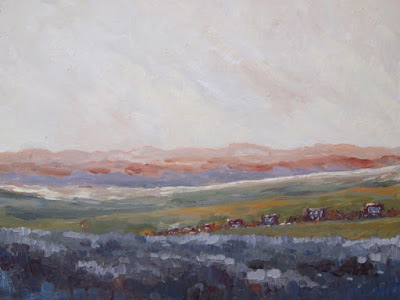
Making it part of my existing universe had pluses and minuses, which I’ll explore in part two of the origins of Beneath the Lanterns. What I want to close with, is a sort of a cautionary tale. As I said at the beginning of this post, I knew that fantasy outsold SF, which was one of the reasons I decided to write a fantasy. (Other than just for the hell of it.) But only after I had written the story did I find out that I had completely misunderstood the fantasy market. (Not that it really matters.)
As you can see from the chart below, the fantasy genre is dominated by Paranormal & Urban fantasy, i.e. vampires and werewolves. If you spin that category into its own genre – which is certainly imaginable since it has, I would imagine, a very specific readership – and you’re left with a Fantasy audience that is probably not much bigger than SF. And thus, nullified my initial premise for writing a fantasy. And then, when you consider that epic fantasy came in second, and I wasn’t writing a million word, multi-volume epic, I was probably chasing a smaller market than SF with my book.
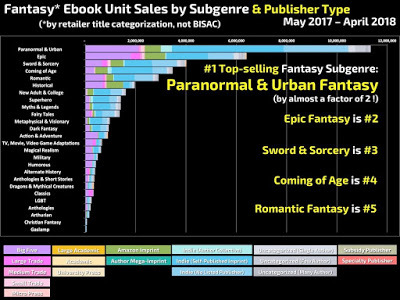
You also have to take into account that Smashwords and Amazon have only so many different sub-genre categories. The only category that I could honestly list Beneath the Lanterns was in “Action and Adventure” and it seems that action and adventure stories are more popular in SF than in fantasy. So instead of chasing a larger market, it seems that I was chasing a smaller one – though in the end, I listed the book in both. Still, the best laid plans…
For some reason Blogger is linking all the captions to the first illustration, and every time I wanted to add a caption, I lost the image. So here are the captions from top to bottom. The First is my first version of the Reed Bank Street, Azera in a very impressionistic style that I was playing around with at the time. The second is another version of the scene in the same style. I used part of this one for one of the covers -- I have never much liked my Beneath the Lantern covers. The next one down is Birdsong Square in a similar style. Then there is a scene of the caravan to Treafara that I did as a potential cover. And finally the graph from the Data Guy's 2018 Nebula Award presentation http://authorearnings.com/sfwa2018/ And below is another version of a caravan painting
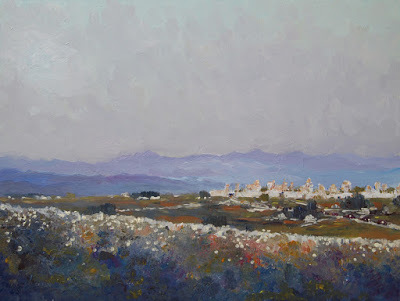
August 10, 2020
The Hugo Awards 2020
This is another one of those post where I direct some comments at the clouds. In short, an opinion piece.
The Hugo Awards for 2020 have come and gone. Finally. Especially for the participants who discovered, to their dismay, that old men like to talk. And talk.
What made the Hugo Awards infamous this year was its master of ceremonies, George R. R. Martin. It seems that George has a hard time finishing things, including his anecdotes. His long winded rambles kept the contestants sweating as they impatiently awaited their fate – the thrill of victory, for the lucky ones, the agony of defeat for all the losers. I tend to feel sorry for all the losers, but then, well, they’re all volunteers, so I guess they took their chances, and lost.
I tried watching the recorded live stream of the show (https://watch.thefantasy.network/the-2020-hugo-awards-livestream/:) to see what it was all about. That lasted five minutes. Well, maybe it was closer to three before I bailed. Whatever entertainment value George possesses as a toastmaster, is lost when he’s just talking to a camera.
But many participants objected to more than just his tediousness. He apparently talked a lot about John Campbell, the golden haired editor of the best-est ever SF magazine, Astounding – at least according to its loyal band of geriatric SF fans. While it is possible that old George was just reminiscing about his youth, it seems more likely that he came to praise Campbell as a deliberate rebuttal of 2019 Hugo winner, Jannette Ng’s efforts to bury Campbell. Certainly, the anti-SJW faction of the SF fandom took it that way.
Speculative fiction by its very nature stories of today, looking forward. There should be no tradition, no orthodoxy in speculative fiction. Let the dead bury the dead. If you’re going to celebrate new books, it should be with today’s rising stars – not the remnants of stars that have faded from the main sequence. But that said, being no fan of awards for creative work, these award ceremonies can be as tedious, controversial, or as contentious as they’re wont to be. I don’t care.

August 5, 2020
My Library -- Travels in Time

I thought I'd take a break from talking about musty old speculative fiction books from half a century ago, to talk about my small collection of musty old travel guides, from 80 to over a 100 years ago. Thirty or forty years ago, if I came across an old travel guide like the ones pictured above, and it was cheap enough, I’d pick it up.
I think maps are cool, and these books had tons of them, making them well worth a dollar or two just for all the maps that came with them. The Blue Guide to Switzerland alone had some 78 maps, many of them in full color. Below are just two of the many foldout maps found in these guides. The top one is of London, and the bottom one is of Paris.
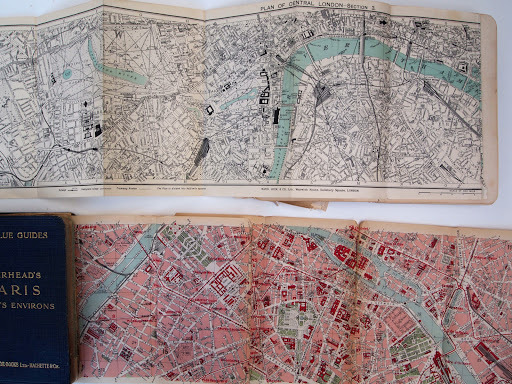
In addition to maps, the books offered a wealth of information, including short histories of the country or city that were the subject of the books, guides to all the various monuments, and extensive lists of other books about their subject matter. The later books also include photographs of the sights described in great detail in the text.
Of even more interest to someone interested in life in the past, is all the everyday information they provided to help the tourist navigate a foreign land. This sort of information can be found at the beginning of the books, under the title of “Practical Information.” For example, A Satchel Guide to Europe, offered information on such things as, Planning the Tour, Selecting One’s Steamship, Clothing and Accessories, Money, and the comparative value of US vs European money, Cost of the Tour, luggage, passports… and the list goes on, including motoring, cycling, and travel by air (in 1928). Guides to single countries and cities would include information on railways, steamers, motor-buses, with typical prices, guides to tips, etc. And, as an extra bonus, most of them included ads for hotels, clothing, insurance, and books, that will take you away to a distant land, far, far ago.
And finally there are the notations one fines on old, secondhand books.
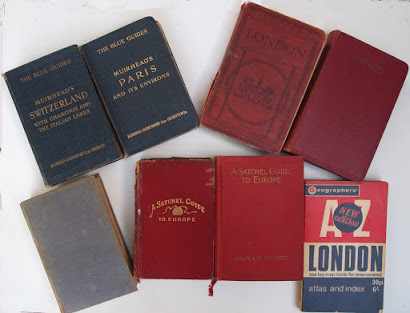
Pictured above are the books in my collection. Left to right, top to bottom.
The Blue Guides – Murihead’s (Findlay Murihead, editor) Switzerland With Chamonix and the Italian Lakes Published by Macmillian & Co, LTD London, and Librairie Hachette, Paris. 1923
The Blue Guides – Murihead’s Paris and its Environs Published by Macmillian & Co, LTD London, and Librairie Hachette, Paris. 1921 (Date written in the book in ink, “Aug 19 -1922” and in pencil, “Hotel Meurice Mrs ITH Scort” or something like that. There is some more writing on the back cover, suggesting that the owner went to London as well. (The time is not far off when only a few historians will be able to read cursive text.)

A Pictorial and Descriptive Guide to London Over One Hundred Illustrations Forty-sixth Edition – Revised Published by Ward, Lock & Co. Ltd, London. An ad page has a small notation “London Guide, 1927-28, so I think we can take 1927 as the date of publication.
Guide to London Fifty-ninth Edition (An ad for the Dalbury Hotel, Knyveton Rd Bournemouth says “Please metion Ward Lock’s Guide 1952” so I think we can take that as this edition’s date.) Ward, Lock, & Co. Ltd, London (and Melbourne)

The Blue Guides Scotland (edited by L Russell Muirhead, the son of Findlay?) With a complete Atlas of Sctoland and 34 other Maps and Plans. Third Edition Published by Ernest Been Limited, London 1949 It used to belong to E. L. Wiregert. I carried this book around during my travels in Scotland, in 1973.
A Satchel Guide to Europe A Satchel Guide for the Vacation Tourist in Europe by W. J. Rolfe First Edition for 1913 Published by Houghton Mifflin Company Boston and New York.
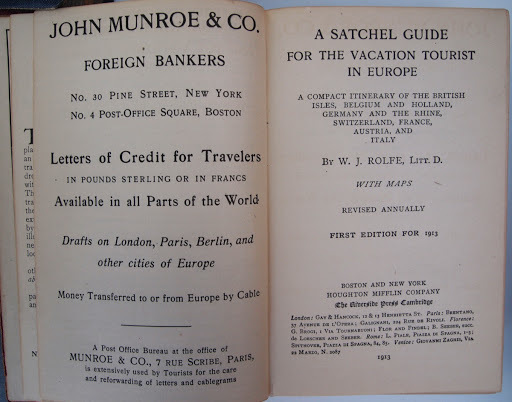 The title Page form A Satchel Guide for the Vacation Tourist in Europe, 1913
The title Page form A Satchel Guide for the Vacation Tourist in Europe, 1913
There is an intriguing little mystery surrounding this book, so I’m going to go into a little more detail on this book. Consider the photographs below, of the left and right leafs of the Memoranda pages in the back of the book.
 Right Page
Right Page Left PageI’ll save you squinting at the photos. The entry starts on the right hand page and goes backwards to the left hand page. The title reads “Proposed Itinerary (JGE)” and in the corner above it “Aug- Sept 1914”
Left PageI’ll save you squinting at the photos. The entry starts on the right hand page and goes backwards to the left hand page. The title reads “Proposed Itinerary (JGE)” and in the corner above it “Aug- Sept 1914”It then has a proposed itinerary starting with “Aug 19 – Wen – Hamburg” and JGE then spends the next two weeks visiting the various German cities before ending up in Rotterdam on Sept. 3. From there its on to Brussels, and then London on Sept 6th. JGE then proposes to spend the next two and a half weeks exploring England, including Cambridge, the Lake District, Liverpool, Southern England, and back to London, and Southampton, no doubt to catch a steamer home.
World War l started on the Western Front on August 3, 1914. So what happened to poor JGE’s Grand Tour? He or she wouldn’t have been on the steamer when the war broke out, and no doubt the winds of war were already being felt in America weeks before, so it seems unlikely that her or she would ever board a steamer for a Germany at war – if there still was passenger service to Germany (unlikely). And so it seems that the Grand Tour never happened, as there are no other notations in the book to suggest that it was merely postponed six or more years. I can almost feel the frustration and sadness of JGE, as his or her dream of trip of a lifetime goes up in the smoke of a senseless war. Life isn’t fair.
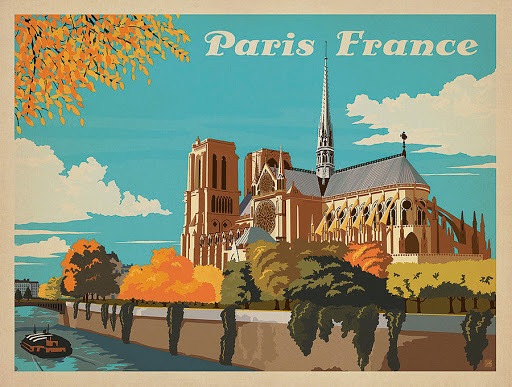
A Satchel Guide to Europe by Wilian J Rolfe The Forty-eighth Annual Edition, revised and enlarged by William D Crockett, Phd (professor of the Latin Language in the Pennsylvania State College Published by Houghton Miffling Company, Boston and New York 1928 (Owned by Charlotte J Dasenbrock, sold by De Forges Books de Luxe Milwaukee)
And finally,
A to Z(Zed) London atlas and index 30p or 6/ (shillings ?) published by Geographer’s Map Company Sevenoaks, Kent.
This one is mine. I picked it up during my Grand Touring of Britain in 1973, making it now 47 years old. Old. In the days before cellphones and GPS a book like this – a street map book of all of London -- in your back pocket was essential to not getting hopelessly lost. Alas, today, the print has gotten too small for it ever to be useful to me again…
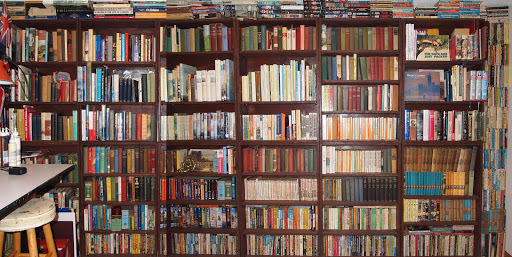
July 30, 2020
Forever Mars
 Image Credit: https://www.jpl.nasa.gov/spaceimages/details.php?id=pia02653
Image Credit: https://www.jpl.nasa.gov/spaceimages/details.php?id=pia02653
I see that the stars must be aligned for voyages to Mars, since three of them have been launched in the last week or so. Which makes this blog entry all the more timely.
Have you ever wondered why there are so many Martian stories? Mars, it seems, holds a special fascination for writers of speculative fiction. One reason for this fascination, at least a century or more ago, was that it seemed possible, even likely, that Mars was an earth-like world, with life, and possibly intelligent life. However, that dream was crushed 55 years ago, when Mariner 4 flew past Mars and showed it to be a cratered planet, much like the moon. Still, many of the speculative writers of that time had grown up reading those earlier Martian stories, and had likely written their own Martian story as well. And probably the same thing can be said for every generation of reader and writer since then – they read Martian stories growing up, and just have to keep reading and writing Mars stories of their own as they grow old.
There is, however, another reason for the abundance of Martian stories. You see, there is a certain, club or lodge, for writers of speculative fiction, known as the Fraternal Order of the Aether. While I say “known as,” it is not well known. Hardly known at all, in fact. The Order is not fond of publicity. It doesn’t award prizes, run contest, or actively seek members. Writers of speculative fiction must seek it out. And that takes some doing. Plus, one must meet certain requirements even to be nominated and elected to membership into the Fraternal Order of the Aether. One of those requirements is, believe it or not,that one must have written a Marian story. Why this is, is a rather murky question. It likely dates back to the Order’s funding, over hundred and twenty years ago, when its early members, writers like Percy Greg, Camille Flammarion, Gustave W Pope, and Edwin Lester Arnold, were all writing stories set on Mars. Be that as it may, this requirement for membership persists to this day. And so, if a speculative writer desires to become a member of the Fraternal Order of the Aether, he or she must write and summit his or her Martian story to the committee in order to have even a chance of being elected to membership. No exceptions. So, you see, dear reader, it likely that many of those Martian stories you have read, and will read, owe their existence the Fraternal Order of the Aether, and its membership requirements.
Now, I’m not the most social fellow you’ll ever run across. I don’t believe that I belong to any organization at moment. Indeed, I believe that my last one may well have been the Cub Scouts. But still, I can't help but think that it might be rather cool to be a fraternal member of the Fraternal Order of the Aether, even if I don’t ever see myself ever looking into the Order’s lodge, since it is located in… Well, I don’t think they want that publicized so I’ll not rustle any feathers by mentioning it. But I can still imagine myself pushing through the august, but unmarked doors of the Aether Club, to be greeted by the hall porter, who would politely direct me to the library, the lounge, or the dining room, as I wont. But alas, one needs a Martian story even to dream of this.
So I have written my Martian story – Kere. Or, more precisely, I’ve completed the first draft of it.
Kere’sfirst draft is a story of some 30,700 words. A novella. I tend to add more words in the subsequent drafts since I find writing the first draft to be hard. And because it is, I’ll settle for some rather sketchy writing just to get to the end of it. However, I like to tinker with words, so that once I have some sort of version down to tinker with, I enjoy fleshing out the story in subsequent drafts. However, in this case, the story is not all that complicated, and probably would be better with less words than more. But, as I tell myself, “Good luck with that!”
At this point Kereis a standalone story, though it could easily be the opening episode of a longer, episodic novel. But I’m happy to have just a story, and have no plans, or even ideas, about what sort of novel length story might follow. I will have more to say about the story itself in the coming weeks, but suffice to say that it is set on Mars. A Mars that is in the same “universe” as The Lost Star Stories, the Tales of the Tropic Sea, and even Beneath the Lanterns.But I think the time frame is a bit earlier, by at least 10,000 years, than any of the those stories. (Though they vary among themselves by more than that.) And since it is set on Mars, it touches on the expeditions sent out by the Terran solar system civilization to distant stars like the Tropic Sea’s Dara lll and the Nine Star Nebula.
My target release date is mid to late September 2020.
But enough for now. Stay tuned.

July 25, 2020
My Library -- The Tom Swifts
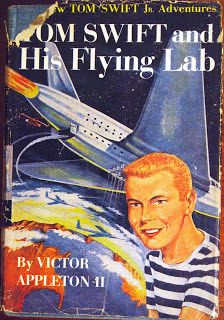
I think it is fair to say that the Tom Swift Jr books served as a gateway to speculative fiction for many boys from the mid 1950’s into the “space age” of the 1960’s. I didn’t hang around with girls in my Tom Swift days, so I can’t say that they didn’t also read them for certain. But I can say that my sister didn’t borrow mine. They certainly were my introduction to speculative fiction, beginning sometime when I was doing time in 5th grade, which is when I first got into reading. I think.
I have no recollection of how I discovered “Victor Appleton ll’s” Tom Swift Jr series. Perhaps there were some Tom Swift Jr books in the classroom library, but I don’t recall that being the case. I do recall with certainty that after I became a fan, I bought most of my Tom Swift Jr books from the book department of the Gimbels department store at the South Gate mall. I can remember eagerly heading to the book department whenever we were shopping to see if a new title was available. I also remember buying one second hand at some sort of street market, a “Maxwell Street Sale” type of event. (Probably Tom Swift and His Flying Lab pictured above since it was not a new copy) I’m quite sure that I bought Tom Swift and the Electronic Hydrolung of 1961 (#18 $1) when it was first released – as it’s wrap around the spine cover was unique to the series, which, somehow, struck in my memory. The last book I bought was Tom Swift and His 3-ZD Telejector with a copyright date of 1964 which would make me 14 years old. By that time I was likely starting to read full on speculative fiction – Heinlein, Clarke, Norton et.al.
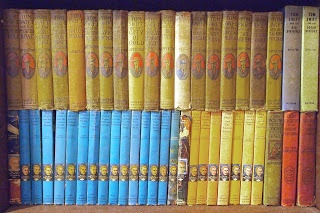
But as you can see from the photo, I did not confine myself to reading just the then current Tom Swift Jr books by Victor Appleton ll. In 1963 there was a brief craze called “Tom Swifties.” You can read about it in this Wikipedia article: https://en.wikipedia.org/wiki/Tom_Swifty The short version is that a book, Tom Swifties by Paul Pease and Bill McDonough, made puns out of the way the writers of the original Tom Swift books used discriptive dialog tags. The Wikipedia article has an example of the way the original books were written and then samples of dialog tags turned into puns, for example: “I love hot dogs,” said Tom with relish.”or “Stay away from that turtle!” Tom snapped. or “We just struck oil!” Tom gushed. You get the idea. I recall seeing a newspaper article about this fad, which opened my eyes to the fact that there was an older, Tom Swift series by Victor Appleton before there was the Tom Swift Jr by Victor Appleton ll series that I was familiar with. This sparked my interest, so much that my Dad drove me into downtown Milwaukee to visit the premiere used book store, The Renaissance Book Store, on Wisconsin Ave. There he negotiated a deal to buy one of each of the titles they had in stock – I seem to think, 13 of them all told, for a $1 apiece. I know that one of the books in that bundle was Tom Swift and his Motorcycle. I wrote the date I got it, 1/12/63 on the inside flap, and it still has the book store’s asking price of $2.50, so Dad got a good deal.
Strangely enough, the original Tom Swift books have had a greater impact on me, my tastes in stories, and my writing, than the Tom Swift Jr books ever did. Whereas the Tom Swift Jr book could be imagined to be taking place in the world I knew, the old books, set in upstate New York in 1910's, were a strange, fantasy world to me. While I was familiar with life in the past, as portrayed in TV westerns and old movies, anyway, these stories brought the past much closer to home. I guess the best way to put it is that they were a glimpse of the everyday life of a teenager/young man of the period – with quaint air of “old times.” And perhaps because I’d spent two weeks every summer on the dairy farm of my grandparents, which was far different than my life in the city and suburbs, I think I had just a taste of that way of life just before it faded away in the 1960’s,so the life the books described had a familiar air to it that enhanced its impact on my imagination.
I would go on to read many other books set in different eras – Sherlock Holmes’ Victorian London, Nayland Smith’s Edwardian East End, Philip Marlowe’s 1930’s LA, to name just few of the lost worlds of the past that had the power of a fantasy world in my imagination. However, Tom Swift’s world was the first.
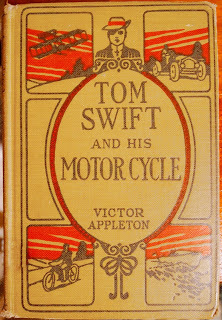
The series started off with Tom making improvements on motorcycle he got cheap from a Mr Wakefield Damon (who blessed everything), and dealing with the obnoxious rich rival/bully, Andy Foger, plus thieves stealing his inventor dad’s plans. Travel distances were still measured in a horse and buggy speed. Like in the Jr books, Tom had a good friend, and a girl he was sweet on (and actually married, in the books, I seem to recall.) Plus some interesting reoccurring characters, like Eradicate Sampson with his mule Boomerang with all the racial stereotypes of the day, but still portrayed sympathetically. As I said, it was a whole new, a different, and a simpler never-never world. A world time had changed to fantasy.
So what do I owe Tom Swift today? Well, let’s see. I like small stories, stories about people in dangerous adventures, but not stories that involve the fate of the world or universe, just like the Tom Swift stories. I like more old-fashioned settings for my stories, even when set in the far distant future. I like the comradely of good friends, and the element of romance. The old Tom Swift books took me out of my everyday life to another semi-familiar, but different world, which is what I try to achieve with my stories. In short, they either appealed to the taste in stories I was born with, or shaped it. I can’t say which. And, well, Tom is shown wearing a snappy hat on the cover. I’ve been a hat guy all my life.
And come to think of it, I owe those old Tom Swift books one more thing – my love of old books. They were my first second hand books, and I found it intriguing to find hints of the previous owners in the books, inscriptions, signatures, etc. I have a lot of old books – books that were actually old before I bought them. I love them.
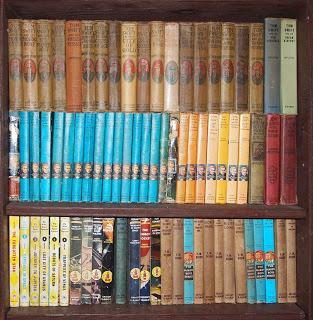
In the photo above, you can see, on the lower shelf, some more of my early reading. I wasn’t a huge fan of the Hardy Boys, but I did read them. Like Tom Swift, I like the older, original versions better than the updated ones, when I could find them. Though dated, the older versions, seemed to be a little more realistic, and rougher and tougher than the sanitized 1960’s versions.
I was a big fan of the Tom Crobett Space Cadet series as well. I guess it was an early TV series, but I never saw that. I knew Tom Corbett only from the Carey Rockwell (with Willy Ley, Technical Advisor) books. I really liked the illustrations of those books. They had a lot of them, featuring rocketships like rocketships were meant to be! Plus plenty of illustrations of our heroes, the interiors of rocketships, and the planets – also as they were meant to be. They were great. I also have the Dig Allen, Space Explorer Adventures, by Joseph Greene, that I was less fond of. These were published by Golden Press who put out series books, that were sort of wanta-be rivals to those published by Grosset & Dunlap. They never quite measured up. Anyway, these books may also have formed my taste in speculative fiction – rocket ships, planets, and adventure. I never evolved beyond a good rousing adventure/romance. Mind-blowing what ifs and weirdness were never my cup of tea.
A few last thoughts. When I was reading the old Tom Swift books, the world they described at that time was only fifty years or so distant. Now they're more than a hundred years distant. The books I read fifty years ago, now don't seem all that old...
I see on Amazon, that someone has now tried to update the original Tom Swift Jr books. I don't know how well that would work, but I doubt that Tom Jr. keeps his "flat top" hair cut.
July 19, 2020
The Constant Rabbit, A Book Review
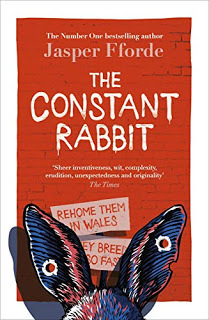
The Constant Rabbit by Jasper Fforde
Published in the UK by Hodder & Stoughton July 2020 (In the US Sept 29 2020)
A book review
I’m a big fan of Jasper Fforde’s work. His Shades of Grey novel of 2009, is probably my favorite speculative fiction book of all time. It was set to be the first of a trilogy, but sales of Shades of Grey disappointed and the remaining two books were canceled. Instead, we have two books, Early Riser, of 2018 and now, The Constant Rabbit of 2020, though he did write three YA books from 2010 to 2014, which where turned into a TV movie.
The Constant Rabbit is foremost a story about bigotry, making it a very timely read. It is also a story about personal redemption. It is set in an alternate England and concerns the efforts of a very vocal, and violent right-wing faction, inside and outside of government, that are bigoted against a certain element of the English population of this story – rabbits.
Rabbits? Well, yes. The blurb: “England 2020. There are 1.2 million human-sized rabbits living in the UK. They can walk, talk, and drive cars, the result of an Inexplicable Anthropomorphising Event fifty-five years ago.” In addition to rabbits, several foxes, weasels, and other animals were also made large, human-like andintelligent during thisEvent. And it seems that similarhappenings have occurred in otherplaces around the world. For example, the intelligent bears in Washington state can shoot hunters in self-defense, which hunters find unfair.The Event is never explained, but then, neither are the crop circles, which continue to appear, in our world, without explanation.
The narrator, Peter Knox, is employed by the government’s Rabbit Compliance Taskforce, as a “spotter”, since he is one of the rare humansthat can tell rabbits apart. This talent serves toaid in every sort of legal mattersconcerning rabbits, from drivers licenses, to marriage, to criminal activity. The story centers arounda femalerabbit, Connie, who was a friend of Knoxfrom his college days. She and her husband move into the village, next door to him. The anti-rabbit leaders of the village want the rabbits out, and want Knox to help them move them along. But though Knox still likes Connie, he has a guilty secret – he was involved in wrongful arrest of Connie’s second husband, who was later murdered by anti-rabbit thugs, which complicates his relationship with her and the rabbits.
This village drama is set against a looming large scale crisis – the government’s plan to rehouse all the rabbits into a single large colony in Wales, where they can be better controlled. Knox is tapped at work to track down a rabbit believed to be part of the rabbit underground.This rabbit soon has connections with his not only his new neighbor, but with his daughter as well, forcing him to make hard and dangerous choices. Dangerous, because his bosses at work are ruthless. There’sa blood thirsty group leader who happens to be a fearful anthropomorphized fox who threatens to gouge out one of his eyesand eat it if he doesn’t cooperate. In short, Knox is between a rock and a hard place, and must try to navigate the complicated and threatening situation as best he can.
While the story is full of Fforde’s wonderful flights of wit and imagination, the story itself is grim, dark,and sad. Bigotry, with the support of government and the complacency of the majority who don’t care enough, is hard, if not impossible, to defeat. And there is no easy victory in this story. Indeed, I think either the author or the editors realized that the story was so grim that a solution is foreshadowed in a number of passages throughout the last half of the book to offer some hope.
As much as I am a fan of Fforde, I’m not a fan of dark stories filled with unpleasant characters. Andwhile Fforde’s wit, imagination, and writing can make me smile, I have to say that this story was too dark for me to enjoy to the fullest. And well, I could never help but wonderwhat I could’ve been reading if Fforde had applied all his wit, creativity, and talent to the third book of the Shades of Greyseries.
In his afterword Fforde says “I am indebted to my agent… and editor … who interpreted a very troublesome first draft of The Constant Rabbit in a positive manner, and were sufficient bold to see that the core idea was sound and something good may come out of it.” While I would hope that it sparks a conversation about the evils of bigotry, which is all to the good. There is, however, still troublesome elements remaining in the story itself. Namely, the ending doesn’t follow from the story he wrote.
I like small stories about people. I don’t mind astory set againstgreatevents impact on the characters. In this book, that great event is the government’s decision to move all 1.2 million rabbits to one colony in order to better keep them in check and exploit their labor. Knox works for the agency in charge of this rehousing, and it would seem that his assignmentis important in this plan. I think. I think finding one of the underground agentsof the rabbits would lead them to the spiritual leader of the rabbits. Takingher into their custody would, perhaps, insure the smooth rehousing of the rabbits. Though the connection isn’t very clear. In addition, Knox becomes involved in the affairs of the rabbits as well, meeting this very spiritual leader, who arranges certain eventsthat will affect Knox’s life. In short, it would seem that our narrator is at the heart of something big, even if he doesn’t know just what it is.
However, when we reach the climax of the story, nothing he did, or happened to him, seems connected to the ultimate outcome. In part this is because the climatic outcome is pulled out of thin air. And even then it has problems, for other characters are given choices that our narrator isn’t – for no apparent reason within the story – only because of the storytelling.
So what we have is one story, on a personal level, as our narrator is torn by the ruthless bigotry of his employers and the leaders of village vshis fondness, if not love, for Connie, and his growing regard for the life and philosophy of the Rabbit Way. The crisis of the rabbit rehousing is playing on the green screen in the background. Knox makes sacrifices to redeem himself in the eyes of Connie and the rabbits, but in the end, those sacrifices are just that – they have nothing to do with the greater events the story is played against. Indeed, while he shows up for the climax, he has nothing to do but help make cucumber sandwiches, which pretty much sums up his involvement.
As a writer, I have issues with this story in that regard. Fforde is writing a satire, and I perhapsthis disconnect could be deliberate choice to highlight the fact that to defeat something like so widespread as bigotry, an individual can only do so much – really, so very little – which is nevertheless, worthwhile. However, as a reader, my concern is more for the characters and story, than for the lessons it may be trying to teach, and so this story does not really work for me. As always, your millage my vary.
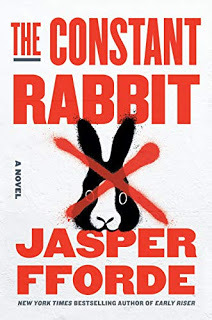
July 14, 2020
Art Is Not A Competitive Sport
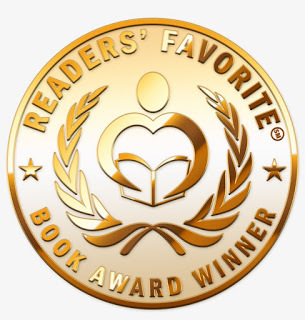 https://www.pngkit.com/view/u2q8e6i1i1e6y3e6_award-transparent-best-seller-clipart-free-library-best/.
https://www.pngkit.com/view/u2q8e6i1i1e6y3e6_award-transparent-best-seller-clipart-free-library-best/.
This is another conversation with the clouds.
Art is not a competitive sport. And yet people turn all sorts of art forms into one. Why? I guess for the thrill of a horse race or a dog fight. There are activities that are inherently competitive – business, for example. But there is nothing intrinsically competitive about the act of creation, of bringing something new into the world. And what is equally important, all art is subjective. It is personal. It is yours to judge. So how can it even be a competitive activity?
Before I proceed further, perhaps I should issue this disclaimer. I think I was in eighth grade when I entered a piece of art in some sort of student art show. It was of a graphic design version of a rocket ship in black and white. It didn’t win anything. That has left me a bitter man for the last sixty years. This bitterness may color my attitude towards awards for art in general, and in this post, the various awards for speculative fiction and fantasy. Just say’n.
So, back to my premise. Art, the creation of something new in the world is not a competitive activity. And that the appreciation of art is entirely subjective. There are no objective measurements for the intrinsic value of art. It is all in the eye of the beholder. If one cares to, one can make a comparison between pieces of art, but that is still subjective. This fact, however, has never stopped people from making a dog fight out of all forms of art. Art, music, books, movies, fashion, design, architecture, indeed, almost any creative endeavor will have contests and awards. Some are determined by juries, other by popularity, but they’re all still subjective judgments. And as artistic judgments they are meaningless. What works for one doesn’t have to work for another. And what works for a million doesn’t mean it has to work for you. Everyone has the right to make their own judgment.
However, let’s be honest, these contests and awards aren’t meant to judge art. They’re meant to serve publicity and commerce. An award means recognition, which can then be parlayed into money. But money, well, isn’t mentioned in polite society, so it is better to pretend all these award are “honoring” the art, rather than generating publicity, and hopefully, sales to follow.
To go from the general, to the specific, let’s talk about awards in speculative fiction.
In the speculative fiction and fantasy field, there are many contests and awards. I’ll just mention just three; The Hugo Award Contest run by the World Science Fiction Society, the Nebula Award Contest run by Science Fiction and Fantasy Writers of America, and the Locus Contest and Award sponsored by Locas Magazine. Each year they hand out awards in various categories from novels to fans magazines. The winners are determined by popularity. Between six and eight thousand speculative fiction fans pay the WSFS money to be able to vote for their favorites in various categories. Some 2,000 professional speculative fiction and fantasy writers choose the winner of the Nebula award, and less than a 1,000 fans pick the Locus winners.
Over the last 40 years, this process has produced only 5 unanimous winners. If art was a competitive activity, and the criteria objective, one would think that there would be a clear winner each year. And when you consider that many of the people making these selections are a small group, most of whom have some connection to the publishing industry, they should be aware of any objective criteria that can be applied to speculative fiction book. Thus, if books could be judged objectively, there should be a universal winner most years.
But of course, there is no objective criteria to judge the artistic merit of a work. So now we are looking at the subjective – and perhaps business loyalty – of these judges. Is their judgment worth anything?
The fact is that more than 50 million SF & F books are sold each year, to likely over a million SF & F readers. This means that less than 1% of those readers decide what is best. And in at least one award, the Nebula Award, the voters are hardly impartial, being peers, friends, and/or rivals of the writers whose work is under consideration. One has to believe that many WSFS members are not casual readers, but people who have connections to specific publishing business that may compromise any impartiality in their choices. Thus, it is hard to believe that apparent popularity is a valid yardstick of worth in these very industry insider awards.
Which brings up the question of what is actually eligible to be judged. Half of the SF & F books sold are indie-published, and for all practical considerations, invisible in this selection process, since this is an exercise of traditional publishing, to promote traditionally published works.
In short, any way you care to look at these awards, winning has no real meaning regarding the craft and creativity of the works nominated and awarded. It is, simply, a yearly exercise in marketing.The best that can said is that awards represent a triumph of the marketing department. I’m certain that this conclusion comes as no shock to anyone. The primary purpose of these awards, and all other such awards for creative work, is to generate recognition that can be turned into money. Winning an award, and indeed, even being nominated for an award, allows a publisher and author to add a “Winner of...” or “... nominee” badge to their books, bios, and websites in the hope that this badge will lend increased credibility for the quality of the book, author, or what have you, which will then lead to increased sales. I assume it works. Heck, if you can buy a jar of orange marmalade that is served to the Queen of England, it has to be good, doesn’t it?
Of course, there is the element of “honoring” works, companies, and people, for their contributions to the industry. While there may be an authentic desire to do so, these organizations can not just settle for just “honoring” people. This too, must be turned into a winner take all contest. Oh, one can say, “I’m honored to have been nominated.” But that’s what the losers always say. And competition always creates far more losers than winners. Really, how is that honoring people? Why not just put the nominated honorees in a cage and have them fight it out like chickens or dogs? Wouldn’t that be a spectacle? I truly think it’s a shame that it seems that we can’t just acknowledge accomplishments, without making it a spectacle of it.
As I said at the beginning, art is not a competitive sport. But business is. And publishing is a business. Authors write books to make money. Books and stories, are written and published in one form or another to make money. And there is an objective criteria for judging the “best” in business. And that is, what earns the most profit. Period.
So, if it is important to determine the “best,” why not look, not at the subjective art, but at the objective reality of commerce. The best book, story, magazine, or any other contributor in the field is “how much money did they bring in?’’ Crass, yes, but objective, and can easily be justified – money, is after all, what the publishing business is about. One can write and publish for noble reasons, but at the end of the day, sales pays everyone’s wages.
So what I say, is let’s see your books – the ones with all those columns of numbers – for each entry, so we can see what one made the most money. Then we'd known what one which really is the BEST. I can get behind that awards program. But until then, I will continue to look on these silly awards contests as the elaborate commercials they are.
It's the award season, let the dogs loose.
July 9, 2020
My Library -- Edgar Rice Burroughs (Part Two)
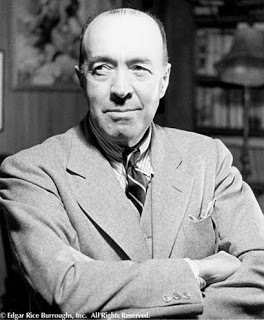 Edgar Rice Burroughs
Edgar Rice Burroughs photo credit: http://www.tarzan.org/bio/26.jpg
This is the second part of “My Library – Edgar Rice Burroughs.” In my first entry, I described how I was surprised to discover that my memories (such as they are) of becoming a fan of ERB were wrong. I had read only half a dozen or so of his books during the my first 5 years of reading speculative fiction. And, for lack of any other explanation, I must have become a big fan of his in the 1968-69 time period, based on fan club material I still have from that time period. Now, in this post I will explore why I think Burroughs came to have had such a lasting influence in my idea of what a story should be.
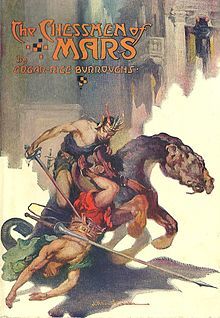 photo credit: https://en.wikipedia.org/wiki/The_Chessmen_of_Mars
photo credit: https://en.wikipedia.org/wiki/The_Chessmen_of_MarsI will begin in a roundabout way. While searching for some photos of Burroughs to illustrate my posts, I came across an article from the Saturday Evening Post issue of 29 July, 1939
https://www.saturdayeveningpost.com/2018/11/how-to-become-a-great-writer/
that perhaps provides some clues. It is an entertaining and very tongue in cheek article by Alva Johnston with the title of; “How to Become a Great Writer.”
It opens with the line, “Everybody sooner or later turns out to be a writer. Get deep enough into anybody’s confidence, and you find that he has manuscripts.” and adds that “...the people are smart. They are on the right trail. Writing is the shortest cut to affluence except inheriting big money.” Right. He does, however, goes on to say that Hollywood was, in 1939, desperately short of writers, and that good ones earned $5,000 a week or more for screen work and that radio-script work writers could earn salaries in 5 figures, per week.
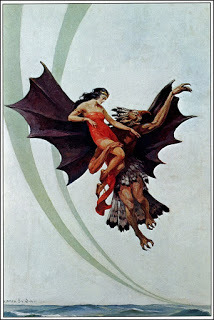 photo credit: http://2.bp.blogspot.com/-XCQzms0Sj4M/T_4jqQTItrI/AAAAAAAByfw/M7dIVvqn0qU/s1600/02_a_venus_stjohn_pirates.jpg
photo credit: http://2.bp.blogspot.com/-XCQzms0Sj4M/T_4jqQTItrI/AAAAAAAByfw/M7dIVvqn0qU/s1600/02_a_venus_stjohn_pirates.jpg
Alva bases “greatness” in the title of the article on three criteria; “1) The size of the writer’s public. 2) His or her success in establishing a character in the consciousness of the world. And 3) The probability of his or her being read by posterity.” (I’ve had to add “or her” to Alva’s copy to make it a little more modern. In 1939 it seems writing was very male, at least in Alva Johnston’s view.) And judged by these tests, Mr Johnston says that "Edgar Rice Burroughs is first and the rest nowhere."
He then lists the “main rules for literary training that can be gathered from the experience of Burroughs. They are: 1) Be a disappointed man. 2) Achieve no success at anything you touch. 3) Lead an unbearably drab and uninteresting life. 4) Hate civilization. 5) Learn no grammar. 6) Read little. 7) Write nothing. 8) Have an ordinary mind and commonplace tastes, approximating those of the great reading public. 9) Avoid subjects that you know about.”
He goes on to describe ERB’s life and Tarzan in Hollywood movies. And, dear to my heart, is how he “escaped grammar.” It was a lucky accident. “He (ERB) was sent first to a private school in Chicago which held that the teaching of English grammar was nonsense and that students should absorb grammar through Latin and Greek. Edgar absorbed no Latin and Greek. He was then sent to Phillips Andover, which, assuming that all freshmen were thoroughly drilled in grammar, ignored that subject. Phillips Andover quickly waived on young Burroughs, and he was sent to military academy, which paid no attention to grammar. Edgar thus became an uninhibited writer, free from the anxieties about moods and tenses which kill spontaneity. Burroughs doesn’t know whether he is grammatical or not, and cares less.”
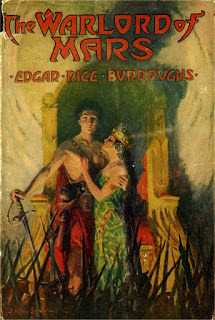 photo credit: https://www.edgarriceburroughs.com/artwork/
photo credit: https://www.edgarriceburroughs.com/artwork/Burroughs is clearly a fellow after my own heart – or perhaps, more correctly, the reverse, I am a follower of Burroughs. I was no doubt taught grammar in high school. I remember that we (as in the class, not necessarily me) learned how to diagram sentences, and such, but I have retained little of what was taught today. I know what a noun is, and a verb, and maybe an adverb, but beyond that…well, the less said the better. And I can’t diagram a sentence today to save my soul. However, I have always maintained that you don’t need to be able to take a car apart and put it back together in order to drive it. Enough. I’ll save that rant for another post. Back to Burroughs.
I’m not going to claim that Burroughs was a great writer. He was, however, a great pulp writer. Perhaps the greatest. He had an amazing imagination which filled his stories with a that all important “sense of wonder.” And with it, he could slyly slip in a bit of satire as well. His narrators and characters were relatable. I’m a sucker for first person narrations, and I always enjoyed traveling along with his narrators. His writing was straightforward, approachable. Like P.G. Wodehouse, he had a story pattern that he used over and over, but, like Wodehouse, he used it well, and made it fresh, at least in his best works. That said, from the few ratings I have preserved, it is clear that his stories didn’t always wow! me.
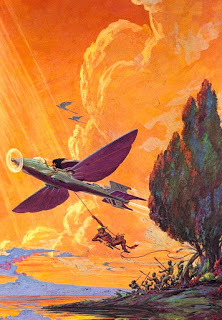 photo credit:http://thejohncarterfiles.com/2011/04/the-roy-krenkel-ace-cover-art-quiz/
photo credit:http://thejohncarterfiles.com/2011/04/the-roy-krenkel-ace-cover-art-quiz/
I’ll be honest, all that said, I have no more desireforrevisiting his stories, than I have for most of the other books I read duringthat time of my life – with the notable exception of the first three books of the Martian series. I’ve already read those books at least four times. Heck,I even read them to the kids as bedtime stories when they were young. For all its shortcomings, A Princess of Marsis still one of my very favorite books. Oh, today, I would certainly like a more completely drawnnarrator, and I would certainly like a princess with more agency, and well, I simply wish there was more to every element of the story. My imagination these days can’t fill in all the sketched in spaces in these pulp tales. But for all its shortcomings, it is still a great book.
Still, as I said, I think that ERB was the greatest pulp writer of his age. Period. He gave them wonderful worlds, bristling with creativity and imagination. He wrote escapist literature, but, at his peak, you escaped.
 photo credit: https://www.pinterest.com/pin/476044623084413343/
photo credit: https://www.pinterest.com/pin/476044623084413343/
In some ways, he is the anti-Heinlein, in that his stature has only grown in my view over the years, even as Heinlein’s shrunk. Part of that growing esteem I have for ERB is that I’ve come to realize just how much of an influence Burroughs has had on my own writing. The basic formula of episodic adventures, tied together with the thread of a romance, especially when related by afirst person narrators,is the formula I use for my stories. Of course, I’d like to think that manyother wonderful writers whoI’ve read, writers like John Buchan, H. Rider Haggard, P. G. Wodehouse, Patrick O’Brian, Raymond Chandler, have also contributed to my ability to write and entertain. But I know that I owe a great debt to Edgar Rice Burroughs. I feel fortunate that I discovered him at an age whenI could fully appreciate his work.
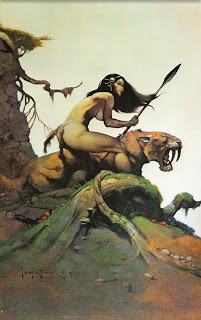 photo credit: https://www.reddit.com/r/FantasyArt/comments/cz5noj/frank_frazetta_art_for_savage_pellucidar_edgar/
photo credit: https://www.reddit.com/r/FantasyArt/comments/cz5noj/frank_frazetta_art_for_savage_pellucidar_edgar/
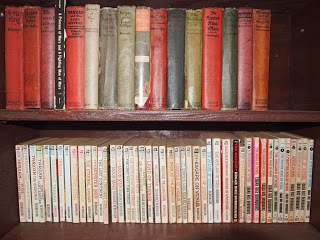 My Burroughs Collection
My Burroughs Collection
July 3, 2020
My Library -- Edgar Rice Burroughs ( Part One)
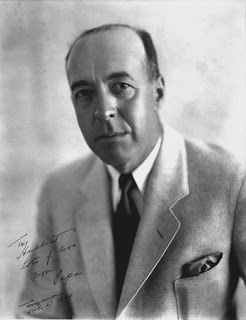 photo credit: https://alchetron.com/Edgar-Rice-Burroughs
photo credit: https://alchetron.com/Edgar-Rice-BurroughsA rather strange thing happened when I started researching my old papers for this post. I found that my current impression of my early relationship with Edgar Rice Burroughs’ works seems to be all wrong. From the photo of my ERB collection below – some 60 books (including at least half a dozen duplicates) – it would seem that I was a huge ERB fan back in the day. I can remember pouring over an Ace catalog (I used to get books from Ace by mail order) with a long list of ERB’s books. They had titles like The Pirates of Venus, and Lost on Venus, which, not knowing ERB at the time, I imagined them to be some sort of typical, Tom Corbett, Space Cadet, Revolt on Venus type of story. I ordered the Venus books, and from the list below, you can see that I loved them. But going over the various other lists of books that I read over the next five years, I don’t find any evidence of when I came to be a tremendous fan of ERB. I was authentically surprised by this.
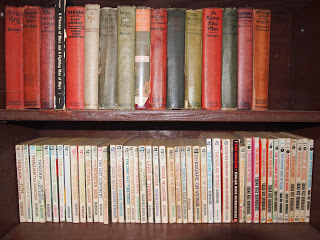 My ERB Collection
My ERB Collection
Here’s my lists of ERB books I read from my “Science-Fiction Books I have Read” dated, 1/6/65.
Pirates of Venus E
Lost on Venus E
Carson of Venus E
Escape on Venus E (It seems that I was a big fan of the Venus series.)
Tanar of Pellucidar C
The Cave Girl C
Beyond the Farthest Star E
The Land That Time Forgot B
The Warlord of Mars B
The Mastermind of Mar C
A Fighting Man of Mars C
Clearly, outside of the Venus series (which I’ve not reread), ERB books were, at this stage, rather hit or miss affairs. There were no new ERB additions in the list I made in September of 1965. And it seems that I did not read even one ERB book in either 1966 or 1967, as I recorded every book I read during those years. Another list dated, March 1968, adds only The People That Time Forgot, and Thuvia, Maid of Marsto my ERB have read list. The only other “books I read” listdatesfrom the years, 1970 &, 71. Itshow that I read A Princess of Marswith an “A” rating, and The Lost Continent, with a “B” rating in April 1971.
It would seem that I wasn’t much of a Burroughs fan at all, based on those lists. But then, how can I explain the ERB related material I still have, pictured below?

The “Barsooniam Bazaar” has a 1968 date. The Barsoomian, #14, a quarterly fan magazine ($2/year), is also copyrighted 1968. The Burroughs Bulletin,#18, the fan magazine of The Burroughs Bibliophiles ($3/year) also is dated 1968. All of this would seem to indicate that I was a pretty devoted fan of ERB by 1968.-- though not devoted enough to actually subscribe to these clubs.I’m cheap. But where are all the ERB books that inspired this interest in ERB? They are certainly not recorded in my records of the time.
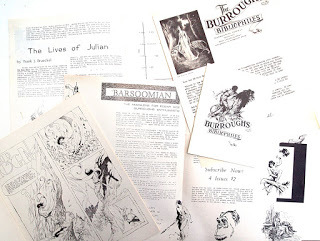
From the dates of this material, I must havestarted collecting the bulk of myERB books when Ace started reissued ERB againin 1968 & 1969. Many of my copies I own now, that I would’ve bought new are “G” series $.50 versions rather than the“F” series $.40 books fromthe early 1960’s. And since there is a blank span in my records of books I read, from March 1968 to 1970, this would seem to be the time frame when I got into ERB. The Lost Continentcopy I have is stamped “9-69” giving some credence to this theory. And the “G” series books I owndon’t have “Neldner’s Point Loomis” stamped on the inside, so they are not from the card shop that supplied me with most of my SF books prior to 1968. I started college in the fall of 1968, and, come to think of it, that “9-69” stamp on the book may have been the practice at the University Book Store. One other piece of evidence is that my Ace paperback version of Richard A Lupoff’s book, Edgar Rice Burroughs: Master of Adventure, came out in 1968. I’m guessing that my interest in ERB took hold in the summer of 1968. I may well have been rereading A Princess of Marsin 1971.
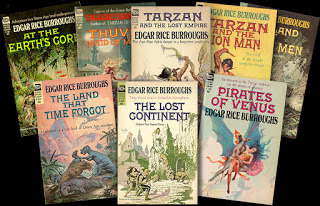 Image credit: https://recoverings.com/blog/the-ace-books-title-font-mystery/
Image credit: https://recoverings.com/blog/the-ace-books-title-font-mystery/That said, the hardcover books, and most of the Ace Tarzan books are books that I picked up second hand from charity rummage sales and such, whenever I came across them as an adult. While I’mnot a big fan of Tarzan, I wouldn’t pass up a cheap ERB book, especially theAce books with their Franzetta and Krendel Jr covers.. Of all the SF paperbackcovers I’ve seen in my life, I think the Frank Frazetta and Roy Krenkel Jr.covers for Ace’s ERB booksare, collectively, the best speculative fiction covers ever. Period.
And that, I guess covers the nuts and bolts of howmy Burroughs collection came to be.
But why do I have 60 Burroughs books on my shelves? Why did I at least look into joining the Burroughs societies? It’s not like I tried to join the Heinlein or Norton fan clubs. Did they have any? So what was it about Edgar Rice Burroughs that even today, makes him special in my mind?
Since this post is running long, and I have much more to say, I’ll answer those questions next time. So stay tuned for Part Two of My Library – Edgar Rice Burroughs
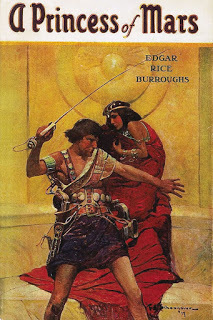
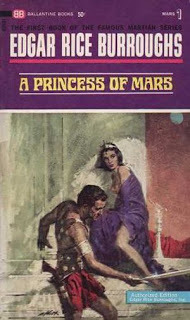
image credit: https://fritzfreiheit.com/wiki/A_Princess_of_Mars
image credits Left: https://en.wikipedia.org/wiki/A_Princess_of_Mars
July 1, 2020
All My Books Are Sale Priced in Amazon's non-US Stores
 Just a short note to my potential non-US customers. All my ebooks now carry a suggested retail price of $.99 or the equivalent in your local currency. This sale will run at least through July 2020 and after that, we'll see how it goes. Hopefully this will have no adverse effect on the books that are free in the US store. But Amazon, being Amazon, who knows?
Just a short note to my potential non-US customers. All my ebooks now carry a suggested retail price of $.99 or the equivalent in your local currency. This sale will run at least through July 2020 and after that, we'll see how it goes. Hopefully this will have no adverse effect on the books that are free in the US store. But Amazon, being Amazon, who knows?



